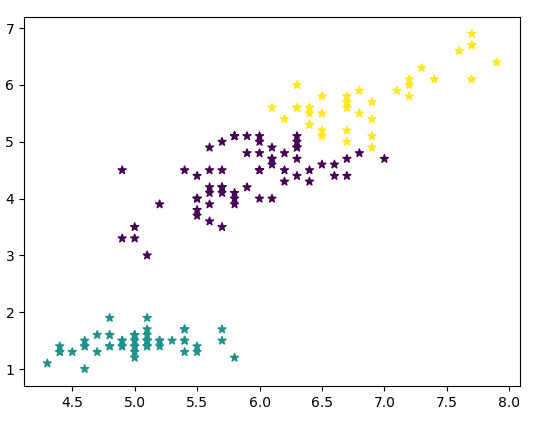1.用python实现K均值算法
import numpy as np
x=np.random.randint(1,100,[20,1])
y=np.zeros(20)
k=3
def initcenter(x,k):
return x[:k]
kc=initcenter(x,k)
kc

def nearest(kc,i):
d=(abs(kc-i))
w=np.where(d==np.min(d))
return w[0][0]
kc=initcenter(x,k)
nearest(kc,93)

for i in range(x.shape[0]):
y[i]=nearest(kc,x[i])
print(y)

def nearest(kc,i):
d=(abs(kc-i))
w=np.where(d==np.min(d))
return w[0][0]
def initcenter(x,k):
return x[:k]
def nearest(kc,i):
d=(abs(kc - i))
w=np.where(d==np.min(d))
return w[0][0]
def xclassify(x,y,kc):
for i in range(x.shape[0]):
y[i]=nearest(kc,x[i])
return y
kc=initcenter(x,k)
y=xclassify(x,y,kc)
print(kc,y)



def kcmean (x,y,kc,k): #计算各聚类新均值
l=list(kc)
flag=False
for c in range(k):
m=np.where(y==c)
n=np.mean(x[m])
if l[c] !=n:
l[c]=n
flag=True #聚类中心发生变化
return (np.array(l),flag)
def xclassify(x,y,kc):
for i in range (x.shape[0]): #对数组的每个值分类
y[i]=nearest(kc,x[i])
return y
flag = True
print(x,y,kc,flag)
while flag:
y = xclassify(x,y,kc)
kc,flag = kcmean(x,y,kc,k)
print(y,kc,type(kc))
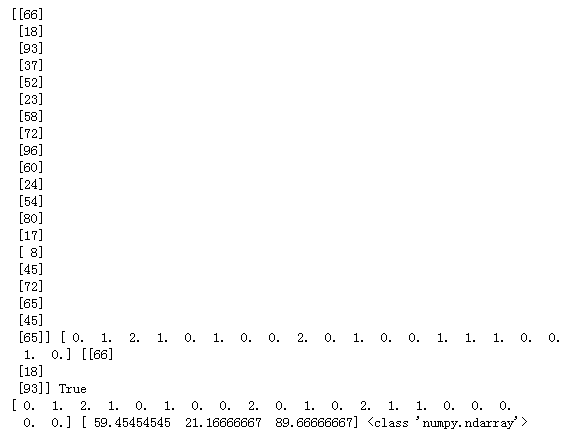
import matplotlib.pyplot as plt
plt.scatter(x,x,s=50,cmap="rainbow");
plt.show()
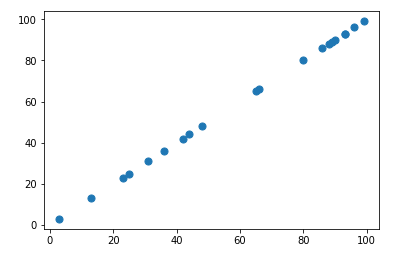
2. 鸢尾花花瓣长度数据做聚类并用散点图显示。
import numpy as np
from sklearn.datasets import load_iris
iris = load_iris()
x = iris.data[:, 1]
y = np.zeros(150)
def initcent(x, k): # 初始聚类中心数组
return x[0:k].reshape(k)
def nearest(kc, i): # 数组中的值,与聚类中心最小距离所在类别的索引号
d = (abs(kc - i))
w = np.where(d == np.min(d))
return w[0][0]
def kcmean(x, y, kc, k): # 计算各聚类新均值
l = list(kc)
flag = False
for c in range(k):
m = np.where(y == c)
n = np.mean(x[m])
if l[c] != n:
l[c] = n
flag = True # 聚类中心发生变化
return (np.array(l), flag)
def xclassify(x, y, kc):
for i in range(x.shape[0]): # 对数组的每个值分类
y[i] = nearest(kc, x[i])
return y
k = 3
kc = initcent(x, k)
flag = True
print(x, y, kc, flag)
while flag:
y = xclassify(x, y, kc)
kc, flag = kcmean(x, y, kc, k)
print(y, kc, type(kc))
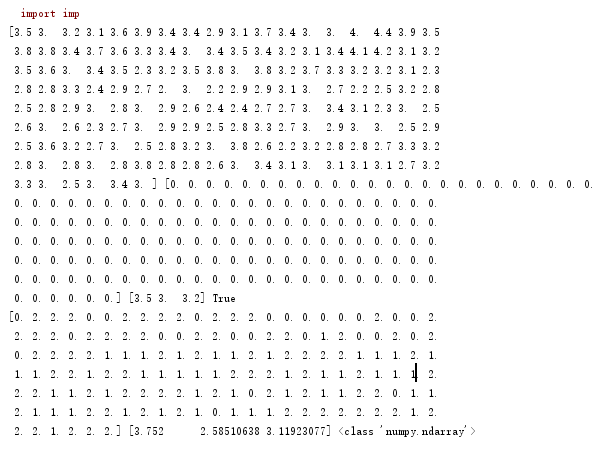
import matplotlib.pyplot as plt
plt.scatter(x,x,c=y,s=50,cmap='rainbow',marker='p',alpha=0.5);
plt.show()
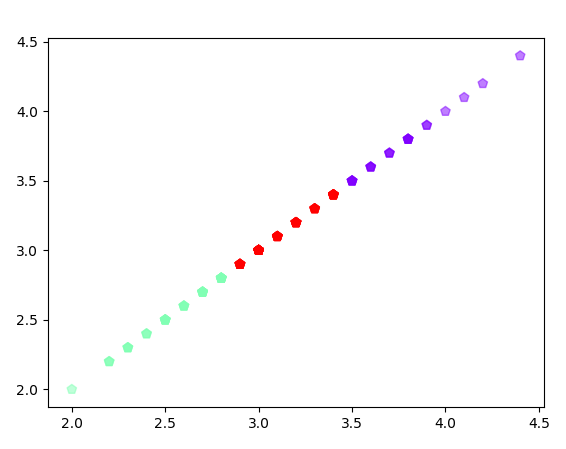
3. 用sklearn.cluster.KMeans,鸢尾花花瓣长度数据做聚类并用散点图显示.
import matplotlib.pyplot as plt
import numpy as np
from sklearn.datasets import load_iris
iris=load_iris()
X=iris.data
print(X)
from sklearn.cluster import KMeans
est=KMeans(n_clusters=3)
est.fit(X)
kc=est.cluster_centers_
y_kmeans=est.predict(X)
print(y_kmeans,kc)
print(kc.shape,y_kmeans.shape,X.shape)
plt.scatter(X[:,0],X[:,1],c=y_kmeans,s=50,cmap='rainbow');
plt.show()
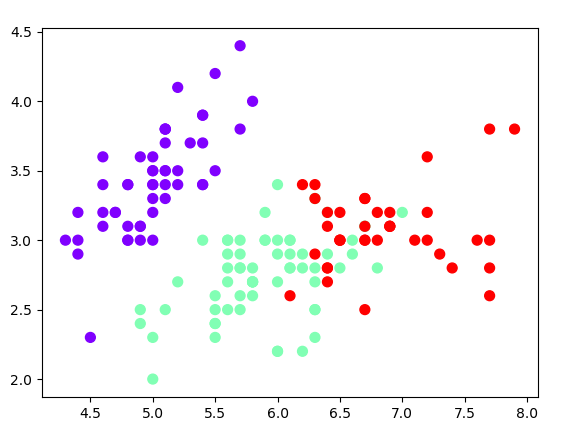
4. 鸢尾花完整数据做聚类并用散点图显示.
from sklearn.cluster import KMeans
import numpy as np
from sklearn.datasets import load_iris
import matplotlib.pyplot as plt
data = load_iris()
iris = data.data
petal_len = iris
print(petal_len)
k_means = KMeans(n_clusters=3) #三个聚类中心
result = k_means.fit(petal_len) #Kmeans自动分类
kc = result.cluster_centers_ #自动分类后的聚类中心
y_means = k_means.predict(petal_len) #预测Y值
plt.scatter(petal_len[:,0],petal_len[:,2],c=y_means, marker='*', label='see')
plt.show()
